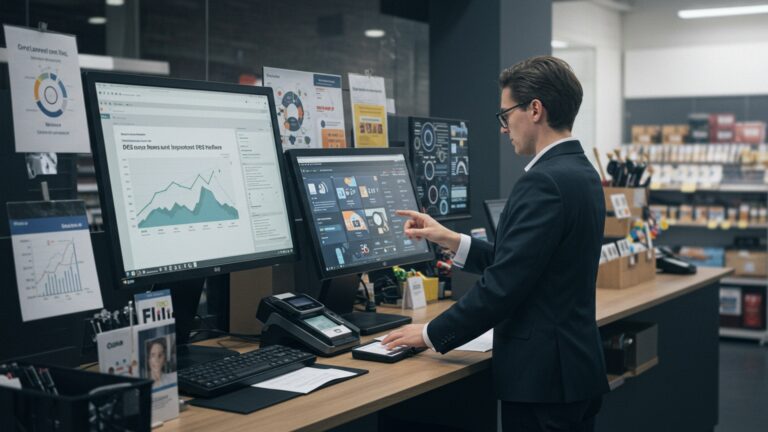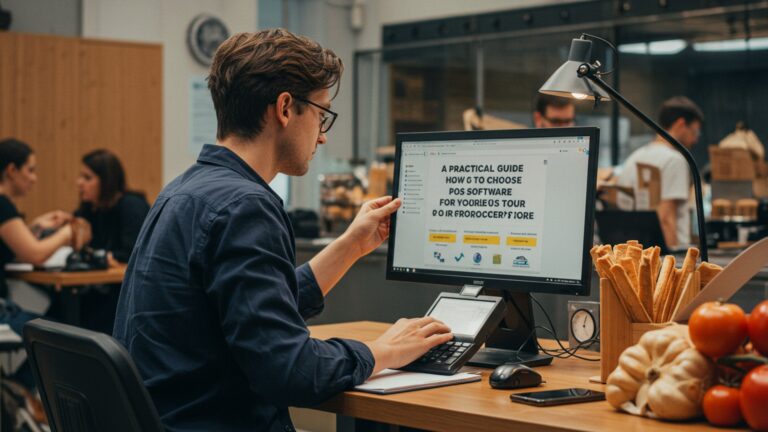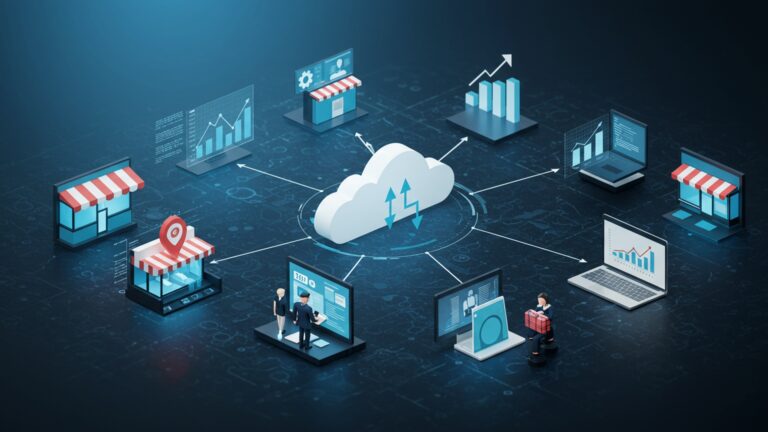Learn How Android POS Software Can Revolutionize Your Sales
In today’s dynamic retail and service industries, businesses constantly seek a competitive edge to streamline operations and elevate customer engagement. Embracing advanced android pos software is no longer merely an upgrade; it’s a fundamental shift towards unprecedented operational agility and data-driven sales growth. Modern enterprises, from bustling quick-service restaurants to mobile pop-up shops, are rapidly transitioning from static, legacy terminals to versatile, cloud-integrated solutions running on ubiquitous Android devices. This technological evolution provides real-time inventory synchronization, comprehensive sales analytics accessible remotely. robust CRM capabilities, transforming how transactions occur and how businesses grasp their market. An Android POS empowers merchants to leverage instant data on peak sales, popular items. customer preferences, facilitating smarter merchandising and personalized service that directly translates into significantly revolutionized sales performance and enhanced profitability.

The Evolution of Point-of-Sale: From Clunky Cash Registers to Smart Devices
The journey of transaction processing has been a remarkable one, evolving significantly over the past few decades. Historically, a “Point-of-Sale” (POS) system referred quite literally to the physical location where a transaction occurred – typically a counter equipped with a cash register, a calculator. perhaps a basic inventory ledger. These early systems, while functional, were often cumbersome, prone to manual errors. offered little in terms of data insights beyond basic sales totals. Managing inventory was a labor-intensive process. understanding customer purchasing patterns was largely guesswork. As technology advanced, we saw the introduction of electronic cash registers, then PC-based POS systems that integrated with barcode scanners and separate credit card terminals. These systems offered more sophisticated inventory tracking and basic reporting. they were often proprietary, expensive to install. required significant IT infrastructure. They were typically fixed installations, tethering the sales process to a specific location within a store. Today, the landscape is dramatically different. The advent of powerful mobile computing, cloud technology. ubiquitous internet connectivity has paved the way for a new generation of POS solutions. Among these, solutions powered by the Android operating system have emerged as a game-changer, democratizing advanced retail technology and making it accessible to businesses of all sizes. This shift is not merely about upgrading equipment; it’s about fundamentally rethinking how businesses interact with customers, manage operations. drive growth.
What Exactly is Android POS Software?
At its core, android pos software is a specialized application designed to run on devices powered by the Android operating system – such as tablets, smartphones, or dedicated Android-based terminals. Unlike traditional, fixed POS systems that rely on proprietary hardware and often complex server setups, Android POS leverages the flexibility and widespread availability of Android devices. The fundamental components of an Android POS solution typically include:
- Android Device
- Android POS Software Application
- Peripherals
- Cloud Backend
This can range from a consumer-grade tablet or smartphone to ruggedized, purpose-built Android POS terminals that integrate screens, printers. card readers into a single unit.
This is the brain of the system, installed directly on the Android device. It handles all transaction processes, inventory management, customer data. reporting functions. These apps are often cloud-connected, meaning data is stored securely online and accessible from anywhere.
Depending on the business needs, these might include barcode scanners, receipt printers, cash drawers. external card readers (though many modern Android POS devices have integrated payment processing capabilities).
Most modern android pos software solutions utilize a cloud-based infrastructure. This allows for real-time data synchronization, remote management of multiple terminals. access to comprehensive analytics from any web browser.
How it works is surprisingly simple yet powerful. When a customer makes a purchase, the sales associate uses the Android device to scan items or input product details. The software calculates the total, applies any discounts. processes the payment (be it cash, credit card, or mobile payment). Simultaneously, the inventory is updated in real-time. the sales data is recorded and sent to the cloud. This seamless integration of hardware, software. cloud services transforms a simple sale into a rich data point that can inform business decisions.
Key Features and Benefits of Android POS Software for Sales Revolution
The adoption of android pos software isn’t just a minor upgrade; it’s a strategic move that can fundamentally revolutionize a business’s sales operations. Here’s how:
- Mobility and Flexibility
- Real-time Inventory Management
- Enhanced Customer Relationship Management (CRM) Integration
- Powerful Data Analytics and Reporting
- Versatile Payment Processing
- Cost-Effectiveness
- Scalability
This is perhaps the most significant advantage. Imagine a busy retail store during a holiday sale. Instead of customers waiting in long lines at fixed registers, sales associates can complete transactions anywhere on the floor using a handheld Android tablet. For restaurants, staff can take orders and process payments tableside, enhancing efficiency and customer experience. Pop-up shops, food trucks. field service businesses thrive on this mobility, allowing them to operate effectively without being tied to a static counter.
Gone are the days of manual stock counts and delayed updates. Android POS software provides instantaneous updates on stock levels with every sale. This means businesses can prevent overselling, optimize ordering, reduce waste. identify fast-moving or slow-moving items to make informed purchasing decisions. For example, a boutique owner can instantly check if a desired size is available in the backroom or at another location directly from their sales floor device.
Many Android POS systems seamlessly integrate with CRM functionalities. This allows businesses to capture customer data, track purchase history, manage loyalty programs. personalize marketing efforts. Knowing a customer’s preferences enables targeted promotions, better service. ultimately, stronger customer loyalty. A coffee shop, for instance, can use this data to offer a free pastry on a customer’s birthday, automatically applied through their loyalty program.
With all sales data flowing into a cloud backend, android pos software empowers businesses with robust analytical tools. Owners and managers can access detailed reports on sales trends, peak hours, employee performance, product profitability. more, often in real-time. This actionable intelligence is crucial for strategic planning, identifying growth opportunities. making data-driven decisions that boost profitability.
Modern Android POS solutions support a wide array of payment methods, including traditional credit/debit cards, contactless payments (NFC), mobile wallets (Apple Pay, Google Pay). even QR code payments. This versatility caters to diverse customer preferences, reduces friction at checkout. can significantly improve conversion rates.
Android devices are generally more affordable than proprietary POS hardware. Moreover, many android pos software solutions operate on a subscription model, eliminating large upfront licensing costs and making advanced technology accessible even for small businesses and startups. The lower hardware cost and flexible software pricing make it a compelling option for budget-conscious businesses looking for powerful capabilities.
As a business grows, an Android POS system can easily scale with it. Adding new terminals or locations is often as simple as purchasing another Android device and installing the software. The cloud-based nature ensures all locations are synchronized and managed from a central dashboard, providing a unified view of the entire operation.
Real-World Impact: Use Cases Across Industries
The versatility of android pos software means its revolutionary impact is felt across a multitude of industries.
- Retail Stores
- Restaurants and Cafes
- Service Businesses
Consider a clothing boutique where queues build up quickly during busy weekends. With handheld Android tablets running POS software, sales associates can “queue bust” by processing sales directly on the shop floor. This not only reduces wait times but also allows staff to stay engaged with customers, offering personalized styling advice while completing the transaction. For pop-up shops or seasonal kiosks, an Android tablet and a mobile card reader are all that’s needed to set up a fully functional sales point in minutes, without the need for extensive infrastructure.
In a bustling restaurant, efficiency is key. Waitstaff equipped with Android tablets can take orders tableside, sending them directly to the kitchen display system (KDS) in real-time. This eliminates handwritten errors, speeds up order fulfillment. allows for quick menu updates. When it’s time to pay, customers can split bills and pay directly at their table using a portable Android POS device, significantly improving table turnover rates and overall customer satisfaction. For a small cafe, managing takeout and delivery orders through an integrated Android POS system streamlines operations, ensuring no order is missed and delivery drivers are dispatched efficiently.
A salon can use android pos software to manage appointments, track client preferences (like color formulas or preferred stylists). process payments right from the styling chair. Field service technicians, such as plumbers or electricians, can complete job orders, generate invoices. accept payments on-site using a rugged Android tablet, reducing administrative overhead and improving cash flow. Even a personal trainer can use it to book sessions, manage client packages. process payments after a workout.
A personal anecdote from a small business owner, Sarah, who runs a craft brewery and taproom: “We used to struggle with our old, bulky POS system. It was slow, crashed often. we couldn’t take orders or payments outside our bar area. Switching to an Android POS system on tablets was a game-changer. Now, during our busy events, our staff can walk around, take orders directly from customers in the beer garden. process payments on the spot. Our sales have increased because we’re serving more people faster. our inventory is always accurate, so we know exactly when to tap a new keg. The reporting features also helped us identify our most popular beers and adjust our brewing schedule accordingly. It’s truly revolutionized how we operate.”
Comparing Android POS with Traditional and Other Modern POS Systems
Understanding where android pos software fits in the broader POS landscape requires a comparison with its predecessors and contemporaries.
| Feature/Aspect | Traditional POS (e. g. , legacy PC-based) | Android POS Software | Other Modern Cloud POS (e. g. , iPad POS) |
|---|---|---|---|
| Hardware | Proprietary, bulky terminals, often requires dedicated PCs. High upfront cost. | Consumer-grade Android tablets/smartphones or dedicated Android terminals. Low to moderate upfront cost. | iPad/iOS devices. Moderate to high upfront cost for Apple hardware. |
| Operating System | Windows, Linux, or proprietary OS. | Android OS. Open-source, widely adopted. | iOS. Proprietary to Apple. |
| Mobility | Limited, typically fixed counter installations. | High, can be used on handheld devices anywhere with connectivity. | High, can be used on handheld devices anywhere with connectivity. |
| Cost (Hardware & Software) | High initial investment, costly maintenance. Often perpetual license. | Lower hardware cost, often subscription-based software. Excellent value. | Higher hardware cost, often subscription-based software. |
| Ecosystem & Customization | Limited integrations, often requires custom development. | Vast Android app ecosystem, strong integration potential with other business tools. | Robust app store, strong integration potential within the Apple ecosystem. |
| Ease of Use | Can be complex, steep learning curve. | Intuitive, familiar interface (like a smartphone/tablet). Easy to learn. | Very intuitive, familiar interface. Easy to learn. |
| Security | Dependent on local IT setup; can be vulnerable if not properly managed. | Cloud-based security, regular updates, device-level security. PCI compliance is key. | Strong device-level security, cloud-based security, regular updates. PCI compliance is key. |
| Offline Capability | Often robust local database. may lack cloud sync. | Many solutions offer offline mode for transactions, syncing when online. | Many solutions offer offline mode for transactions, syncing when online. |
While modern cloud-based POS systems, including those running on iOS, offer similar benefits in terms of mobility and cloud integration, android pos software often stands out for its cost-effectiveness and the sheer variety of hardware options available. The open nature of Android allows for greater flexibility in hardware choices, from budget-friendly tablets to highly specialized, integrated terminals designed for specific industry needs. This democratizes access to advanced POS technology, making it a viable option for a broader range of businesses.
Implementing Android POS Software: A Step-by-Step Guide for Businesses
Migrating to or setting up an android pos software system doesn’t have to be daunting. Here’s an actionable guide to help businesses make a smooth transition and maximize their sales potential:
- Assess Your Business Needs
- Research and Select Android POS Software
- Features
- Ease of Use
- Integrations
- Pricing
- Customer Support
- Scalability
- Security
- Choose Your Android Hardware
- Tablets/Smartphones
- Integrated POS Terminals
- Peripherals
- Data Migration and Setup
- Staff Training
- Test Thoroughly
- Go Live and Monitor
Before looking at any software, clearly define what your business needs. What are your peak sales periods? How many transactions do you process daily? Do you need inventory management, CRM, employee management, or specific industry features (e. g. , table management for restaurants)? What is your budget for hardware and software? Understanding these requirements will narrow down your options.
There are numerous excellent android pos software providers. Look for solutions that match your assessed needs. Key considerations include:
Does it have all the functionalities you require?
Is the interface intuitive for your staff?
Does it connect with your existing accounting software, e-commerce platform, or loyalty programs?
comprehend the subscription model, transaction fees. any hidden costs.
Good support is crucial, especially during setup and in case of issues.
Can the system grow with your business?
Ensure it’s PCI compliant and offers robust data protection.
Many providers offer free trials, which are invaluable for testing the software in your actual business environment. Consider reputable providers like Square POS, Loyverse POS, or Lightspeed Retail, among others. compare their Android offerings.
Based on your software choice and business environment, select appropriate Android devices.
Cost-effective for mobility. may require external peripherals.
Purpose-built devices that combine screen, printer. card reader. More robust for high-volume environments.
Barcode scanners (handheld or integrated), cash drawers, receipt printers. Ensure they are compatible with your chosen android pos software.
Import your existing product catalog, inventory data, customer details. employee profiles into the new system. This step requires careful planning to ensure data accuracy. Configure settings such as taxes, discounts, payment methods. user permissions.
Effective training is paramount for a smooth transition. Train your staff on how to use the new android pos software for sales, returns, inventory checks. end-of-day procedures. Highlight the benefits for them, such as faster transactions and easier access to data, to encourage adoption.
Before going live, conduct comprehensive tests. Process dummy transactions, perform returns, check inventory updates. test all payment methods. Ensure all hardware components (scanners, printers, card readers) are functioning correctly. This helps identify and resolve any issues proactively.
Launch your new Android POS system. During the initial period, closely monitor its performance, gather feedback from staff. be ready to address any unforeseen challenges. Most android pos software providers offer excellent support, so leverage their expertise.
Actionable Takeaways: Maximizing Your Sales Potential with Android POS
To truly revolutionize your sales with android pos software, focus on these actionable strategies:
- Embrace Mobility for Customer Engagement
- Leverage Real-time Data for Smart Decisions
- Integrate and Automate
- Personalize the Customer Journey
- Stay Updated and Secure
- Train for Proficiency, Not Just Basic Use
Don’t just use your Android POS at the counter. Empower your staff to move around the sales floor, engage with customers, offer product details. complete sales on the spot. This personalized service significantly enhances the customer experience and can lead to impulse purchases. Think of it as bringing the checkout to the customer.
Regularly review the sales reports and analytics provided by your android pos software. Identify your best-selling products, peak sales times. top-performing employees. Use this data to optimize staffing schedules, refine product offerings. launch targeted marketing campaigns. For instance, if data shows a dip in sales on Tuesdays, consider a special promotion for that day.
Connect your Android POS with other critical business tools like accounting software (e. g. , QuickBooks, Xero), e-commerce platforms. customer loyalty programs. This automation reduces manual data entry, minimizes errors. creates a holistic view of your business operations, freeing up time to focus on sales and strategy.
Use the CRM features within your android pos software to collect customer data and purchase history. Use this details to offer personalized recommendations, send targeted promotions. create a truly bespoke shopping experience. Knowing a customer’s past purchases allows for highly relevant upselling and cross-selling opportunities.
Regularly update your Android POS software and device operating system. Updates often include new features, performance improvements. crucial security patches. Staying current ensures your system remains efficient, secure. compliant with the latest payment processing standards.
Go beyond basic transaction processing in your staff training. Teach them how to use advanced features like inventory lookups, customer profiles. discount applications. The more proficient your staff, the more effectively they can leverage the full power of your android pos software to drive sales and provide exceptional service.
Conclusion
The true power of Android POS lies in its unparalleled adaptability, fundamentally transforming how you engage customers and manage your sales. Forget the limitations of static terminals; imagine your sales associate closing a deal on the shop floor, instantly checking stock. processing payment right there, much like the sleek mobile checkouts seen in leading fashion retailers today. My personal tip? Don’t just install an Android POS system; truly integrate it into your entire customer journey. For instance, leverage its real-time analytics to identify peak sales hours and optimize staffing, a game-changer I’ve seen empower small businesses to significantly boost their weekend revenue. This proactive approach, driven by seamless transactions and invaluable data insights, isn’t just about efficiency; it’s about building lasting customer loyalty and future-proofing your business in today’s dynamic marketplace. Embrace this innovation. watch your sales figures not just grow. truly flourish.
More Articles
Unlock Flexibility How to Implement Android POS Software for Your Business
Unleash Business Mobility How to Implement Mobile POS Software Solutions Seamlessly
A Complete Guide How to grasp and Use Essential POS Software Features
Future Proof Your Business How to Leverage Cloud Based POS Software Benefits
Simplify Your Transactions How to Master POS Billing Software for Accuracy
FAQs
What exactly is Android POS software?
It’s a point-of-sale system that runs on Android devices like tablets or smartphones. Think of it as your cash register, inventory manager. sales tracker all rolled into one app. much more portable and often more user-friendly than older, bulky systems.
How can this software really boost my sales?
It revolutionizes sales by making transactions faster and smoother, which significantly improves customer experience. You can process payments anywhere, manage inventory in real-time to avoid stockouts. even access customer data to personalize offers, all leading to more efficient operations and higher-value sales opportunities.
Is it complicated to set up and use for my team?
Not at all! Android POS systems are generally known for their intuitive interfaces. If your team can use a smartphone, they can likely pick up an Android POS system quickly. Most come with straightforward setup guides and minimal training requirements, making adoption easy.
What types of businesses are a good fit for Android POS?
Pretty much any business, big or small, that deals with sales directly to customers. Retail stores, restaurants, cafes, food trucks, pop-up shops, service businesses. even mobile vendors can all benefit immensely from the flexibility and features of an Android POS system.
Beyond just taking payments, what else can Android POS software do?
Oh, it does a lot more! Many systems include robust features like inventory management, employee tracking, detailed sales reporting, customer relationship management (CRM) tools, loyalty program integration. even options for online order integration. It’s truly a comprehensive business management tool.
How secure is my business and customer data with an Android POS?
Security is a top priority for reputable Android POS providers. They employ various measures including encryption for transactions, secure cloud storage for data. compliance with industry standards like PCI DSS. Always choose a trusted provider to ensure your data and your customers’ details are well-protected.
What’s the biggest advantage of choosing an Android POS over a traditional system?
The biggest advantage is its unparalleled flexibility and cost-effectiveness. You can use affordable Android hardware, easily scale your system as your business grows. take your sales operations mobile. Plus, the app-based nature means frequent updates and new features are often rolled out without needing expensive hardware upgrades.






